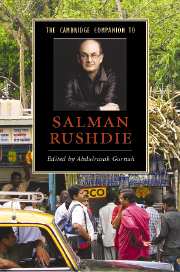Book contents
- Frontmatter
- 1 Introduction
- Part I: Themes and Issues
- Part II: Studies of Individual Texts
- 6 Tricksters and the common herd in Salman Rushdie’s Grimus
- 7 Themes and structures in Midnight’s Children
- 8 Reading ‘Pakistan’ in Salman Rushdie’s Shame
- 9 The Satanic Verses: ‘To be born again, first you have to die’
- 10 The shorter fiction
- 11 The politics of the palimpsest in The Moor’s Last Sigh
- 12 The Ground Beneath Her Feet and Fury: The reinvention of location
- Guide to further reading
- Index
- Series List
12 - The Ground Beneath Her Feet and Fury: The reinvention of location
from Part II: - Studies of Individual Texts
Published online by Cambridge University Press: 28 November 2007
- Frontmatter
- 1 Introduction
- Part I: Themes and Issues
- Part II: Studies of Individual Texts
- 6 Tricksters and the common herd in Salman Rushdie’s Grimus
- 7 Themes and structures in Midnight’s Children
- 8 Reading ‘Pakistan’ in Salman Rushdie’s Shame
- 9 The Satanic Verses: ‘To be born again, first you have to die’
- 10 The shorter fiction
- 11 The politics of the palimpsest in The Moor’s Last Sigh
- 12 The Ground Beneath Her Feet and Fury: The reinvention of location
- Guide to further reading
- Index
- Series List
Summary
The Ground Beneath Her Feet (1999) and Fury, published two years later in 2001, warrant critical attention as a pair of texts not only because of their overt intertextual references, nor even because they are bound together by the density of their shared themes, concerns and attitudes, but also because they represent a profound ideological shift in Rushdie's writing. The shift began to emerge in his non-fiction from as early as 1992 but remained embryonic in his major fictional work until the publication of The Ground Beneath Her Feet. It is signalled most obtrusively there by the relocation of Rushdie's imaginative geography away from the Indian subcontinent. Fury consolidates this departure; whilst the earlier novel had embedded substantial portions of the narrative in Bombay, this latter work barely touches upon Indian space at all, except for a few oblique references to the childhood of its protagonist, Professor Malik Solanka. Although India figures in the narrative as the site of a repressed but nevertheless significant trauma, the putative centre of this novel, as in The Ground Beneath Her Feet, is the West and specifically the United States. In place of Bombay, which Rushdie had chronicled with almost Dickensian exhaustiveness, there is New York, 'the beating heart of the visible world'. The reasons for this shift, and its effects on Rushdie's fiction, will be the object of this essay.
Accompanying the geographical relocation are two other themes that bind The Ground Beneath Her Feet and Fury together: globalisation, driven by the irresistible energies of consumer capitalism, and a global media and telecommunications network with its attendant culture of celebrity.
- Type
- Chapter
- Information
- The Cambridge Companion to Salman Rushdie , pp. 169 - 184Publisher: Cambridge University PressPrint publication year: 2007
- 5
- Cited by

